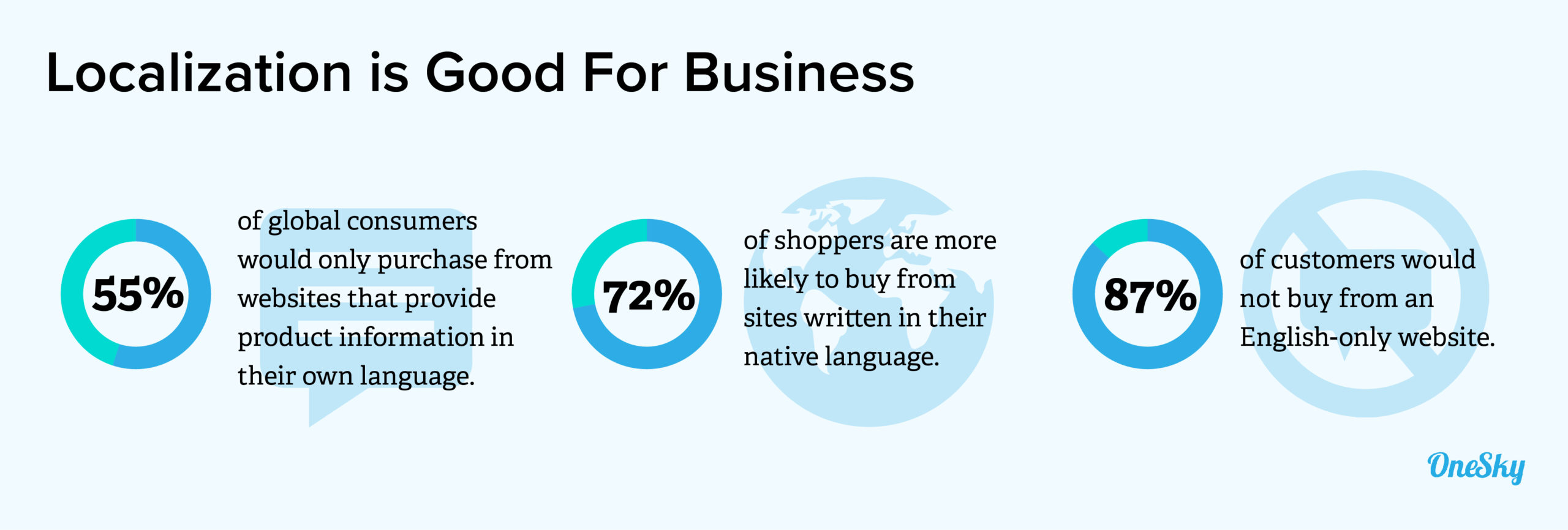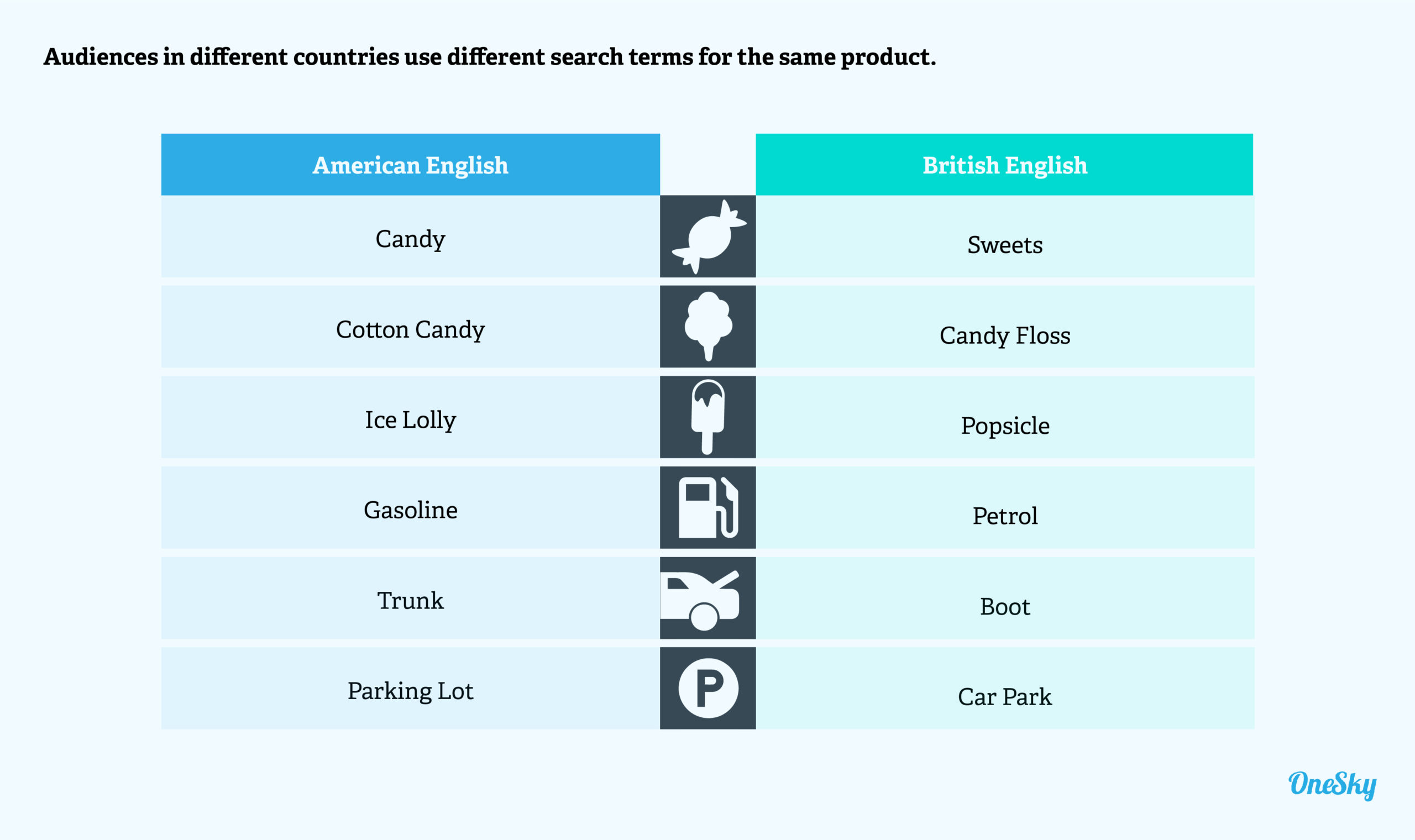12 Steps To Winning the Website Localization Game
If you plan to expand into the global market and sell your products or services in other regions, you have probably heard of website localization. But what does it entail, and how to successfully launch a localized website? Read on to find out.
What Is Website Localization and What Are the Benefits?
Website localization, also called l10n, refers to the process of appropriating the content in a website to reach audiences who are in a different region, have a different cultural background, and/or prefer a different language.
Why Should You Care About Website Localization?
Localizing a website is a time- and labor-intensive process. So why should you bother? Here are the many advantages that localization brings to the table:
- Break into new markets, build brand awareness among new audiences, increase market penetration, and open new revenue opportunities.
- Make it easy for local audiences to navigate your website and find the products they need, so they’re more likely to make a purchase.
- Improve local SEO rankings so you can get found by more high-quality prospects.
- Create relatable content, which can increase engagement and sharing. This will help you increase reach through word-of-mouth marketing.
In fact, 55% of global consumers say they’d only purchase from websites with product information in their native tongue, and 72% are more likely to buy from sites written in their own language.

How To Localize a Website: Key L10n Steps To Follow
Now that we know website localization is good for business, the next question is, how to make website multilingual? Here are the critical steps to follow:
1. Define Languages and Regions
Website localization is a substantial undertaking. It’s often best to localize for one region before you apply the experience to other markets. How do you decide which market to enter first?
Take a look at your website analytics to see where your foreign customers come from. Those will be good starting points for your website localization effort.
Also, perform keyword research for specific locations to determine the demand for your products or services. You may find untapped markets into which you can swoop in and gain the first-mover advantage.
2. Identify Your Target Audience
Just like any online marketing strategy, you must know your audience. This is even more important when you enter a new and unfamiliar market. Don’t make assumptions!
Besides the usual information in a buyer persona, such as demographics, preferences, pain points, etc., expand your research to gain a holistic understanding of the market condition.
For example, find out if local buyers can afford your products, how much they’re willing to pay, and what features they find most valuable. You should know what your competitors are charging, how your prospects prefer to shop, and how they prefer to pay.
3. Assemble Your Localization Team
A localization team involves experts from various disciplines, such as tech, project management, design, marketing, linguistics, and more.
Developers will supply the source code. A localization manager will coordinate the workflow and assign tasks to team members. Then, translators will work on the content, and reviewers will conduct quality assurance to correct mistakes. Lastly, the development team will launch the localized content.
To coordinate all the moving pieces, you can use a localization platform to orchestrate the translation work and keep all the workflows in one place.

4. Internationalize Your Website
Before localizing any content, your website should have gone through a process called internationalization (i18n), so translated text can be easily incorporated into local websites.
Your programmers should use Unicode (UTF-8), which is the industry standard that supports all languages. Your development team should work with your translators to divide the source codes and define the translatable strings so the data can be adapted to new languages.
You also need to enable codes for local preferences, such as specific formats for addresses, date and time, numbers, local calendars, and currencies. This will reduce friction and confusion along the buying journey and help increase conversion rates.
5. Localize Your Website Design
Even a website with a flexible template will require some design work to ensure that imagery, color palettes, and other graphic elements are optimized to appeal to the local market. Page layouts should accommodate the browsing behaviors of the target audience, so they can easily locate the information they need.
Select photos that resonate with the local audience. For example, a U.S. family enjoying a white Christmas won’t trigger the same emotional response in an audience located in Australia or Brazil, where Christmas is in the summer.
Make it easy for users to select site language. Also, localize functional elements, such as form fields (e.g., address and phone numbers,) measurement units, currencies, and time/date formats for a frustration-free user experience.
6. Localize Your Messaging
Creating effective marketing content for a local market is more than just translating what you have on the English website. Get the messaging spot on by addressing the cultural differences so you can deliver the intended customer experience.
While you should keep your brand image and message consistent, it doesn’t mean word-to-word translation. Aim to create a similar emotional impact across different audiences by tapping into local and cultural references.
This process is called transcreation. Work with a linguistic specialist to evaluate your content, so you can effectively preserve the intent, style, tone, context, and emotional impact of your marketing message when it’s translated into different languages.
7. Translate Your Content
Content translation is a critical component in any website localization project. Various translation platforms and services can help you streamline the process and manage all the moving parts.
While you can use machine translation to facilitate the process, it’s advisable to have a local expert review the final content to ensure that it’s getting the point across effectively and resonating with the local audience.
8. Multilingual Website SEO
All the hard work you invest into localizing your website will be for naught if your target audience can’t find it! As such, don’t overlook multilingual SEO, which helps your website show up on relevant searches in your local markets.
Audiences in different regions have different search behaviors. They may use different search terms that aren’t direct translations of the keywords you target in English. They may also describe their pain points or desired outcomes differently.
Successful multilingual SEO starts with comprehensive keyword and market research for the region. You should know how consumers search for products similar to yours and talk about issues that your products can solve for them.

9. Check Local Laws and Regulations
Different countries have different laws concerning online business and activities. From what claims you can make in a marketing message to whether comparative advertising is acceptable, find out what’s allowed so you don’t land in hot water.
In particular, pay attention to differences in data privacy laws. They affect how you obtain permission to use customer information, how you collect data from website visitors, where you store the data, and what you can subsequently do with it.
You should also check regulations on marketing campaigns. For example, what’s the kind of permission you need to obtain before sending promotional emails to prospects and customers? Do your legal research and consult local experts before launching your website.
10. Optimize Site Speed
Internet users in different countries have varying expectations when it comes to site speed. What works for visitors in one country may be deemed too slow in another. Find out what’s important for the audience so you can balance a rich experience with load time.
If a large portion of the audience in a region has slow internet connections, consider simplifying your website to improve load time. For example, clean up the code (e.g., minify the HTML and remove unnecessary CSS), optimize the images, and host your videos on a third-party site (e.g., YouTube.)
You should also consider the percentage of users who will be accessing your site via mobile devices. If mobile usage is high in your target region, site speed is even more critical to ensure that visitors don’t get impatient and leave your site.
11. Use the Right Localization Management Software
Localization 101: don’t even think about doing it manually! Trying to manage multiple teams across different time zones by emailing a spreadsheet back and forth is a disaster waiting to happen.
A localization and translation management software can help you orchestrate complex workflows, ensure that everyone is on the same page, enhance the transparency of the entire project, eliminate bottlenecks, and make sure that nothing falls through the cracks.
Choose a platform that has a robust API to enable automation. It should offer collaborative features so team members can communicate effectively by sharing comments, notes, and feedback all in one place. It should also include a translation memory feature so you can cut down on repetitive tasks.

12. Test, Test, and Test More
After everything is ready to go, take a deep breath! Check your website on all devices and platforms to make sure the content is displayed as intended. For example, different text lengths in the translated copy can impact layout, so you may need to adjust spacing or image size accordingly.
Your new market may have different device or browser preferences. Consumers in some regions may prefer to switch between mobile and desktop for various tasks. Test your site based on local browsing habits to ensure a seamless user experience.
Additionally, don’t forget to learn how your audiences respond to your content. Set up A/B tests and analyze your website metrics to see what works for the audience in each locale.
Keep Your Eyes On the Prize
The complexity of website localization can be intimidating. We get it!
All the complicated workflows and technologies aside, don’t lose sight of the ultimate goal — to connect with the local audience so you can build brand awareness, cultivate relationships with them, and ultimately, turn them into customers and expand revenue opportunities.
To that end, keep these simple but timeless localization best practices in mind:
- Implement cultural elements: From the basics such as date formats and local holidays to slang and cultural references, know your market so you can tap into the audiences’ emotions.
- Deliver an authentic experience: Vet out unnatural phrasing and vocabulary that make your brand sound like an outsider. Don’t skimp on getting the help of linguistics and local experts!
- Pay attention to details: Discrepancies and inconsistencies (e.g., a different currency at checkout) can diminish trust in your brand and make your customers hesitant to complete their purchases.
While we can’t give you an easy button to get website localization done with a snap of a finger, we’re making it pretty darn close. OneSky offers an end-to-end localization solution that covers 50+ languages so you can translate, localize, and test your apps, games, and websites all in one place.
See how our translation management platform works and get started for free today.



 Written by -
Written by - 




 Written by
Written by 



Great insights! Website localization is essential for reaching new markets, enhancing user experience, and boosting brand visibility and engagement.